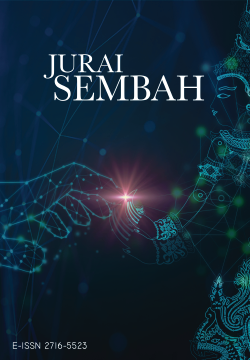Sustainability of Indigeneous Music Culture through Video Documentation
DOI:
https://doi.org/10.37134/juraisembah.vol2.1.2.2021Keywords:
culture, Dayak Bahau, music, revitalization, sustainabilityAbstract
The aim of the Sape Karaang Sustainable Project, a short video product with a narrative that is inhibiting and supporting the sustainability of sape karaang, folklore, music and cultural heritage of the Dayak Bahau people, is to revitalize the musical culture of the Dayak Bahau tradition. This project combines the interest of the Bahau youth in technology and the forms of conservation that parents of the Bahau culture want. The people who want to be achieved from this product are Dayak Bahau and Indonesia. The purpose of this paper is to discuss a practice-led approach used in empowering selected Bahau young people. The method used is a practice-led approach, which is useful in providing guidance to researchers in finding realistic practices, bridging the gap between theory and practice during the project. This paper presents two important arguments: practical approach and visibility in the decision-making process during a research project; and innovation to sustain indigenous traditional arts.
Downloads
References
Boyu, Z., Hui, Y., & Schippers, H. (2015). The Rise and Implementation of Intangible Cultural Heritage Protection for Music in China. The Word of Music 4(1), 45-60.
Chan, C. S. C., & Saidon, Z. L. (2017). Advocating Contemporary Traditional Indigeneous Semai Music Through an Exploration of Youth Interest. IJARBSS, 7(7), 440-449. http://dx.doi.org/10.6007/IJARBSS/v7-i7/3114
Candy, L. (2006), Practice-based Research: A Guide, Reativity & Cognition Studios, Sydney
Cattani, G., Ferriani, S. and Colucci, M. (2015), “Creativity in social networks: a core-periphery perspective”, in Candance, M., Lorenson, M. and Sapsed, J. (Eds), The Oxford Handbook of Creative Industries, Oxford University Press, Oxford.
Gilson, L. (2015), “Creativity in teams: processes and outcomes in creative industries”, in Candance, M., Lorenson, M. and Sapsed, J. (Eds), The Oxford Handbook of Creative Industries, Oxford University Press, Oxford.
Grant, C. (2014). Music Endangerment: How Language Maintenance Can Help. New York: Oxford University Press.
Harrison, K. (2012). Epistemologies of Applied Ethnomusicology. Ethnomusicology 56(3), 505-529. https://doi.org/10.5406/ethnomusicology.56.3.0505
Howard, K. (2012). Music as Intangible Cultural Heritage: Policy, Ideology and Practice in the Preservation of East-Asian Tradition. Farnham, United Kingdom: Ashgate.
Huvat, Y, J. (2014). Teknik Permainan Musik Sapeq dalam Budaya Masyarakat Suku Dayak Bahau. Thesis, Institut Seni Indonesia Surakarta.
Irawati, E. (2016). Transmisi Kelentangan dalam Masyarakat Dayak Benuaq. Resital, 17(1), 1-18. https://doi.org/10.24821/resital.v17i1.1686
Kaufman, J.C. and Sternberg, R.J. (2015), “The creative mind”, in Candance, M., Lorenson, M. and Sapsed, J. (Eds), The Oxford Handbook of Creative Industries, Oxford University Press, Oxford, pp. 33-49.
King, V.T., (1993). The People of Borneo. Oxford: Blackwell
Marett, A. (2010). Vanishing Songs: How Musical Extinctions Threaten the Planet. Ethnomusicology 19(2), 249-262. https://doi.org/10.1080/17411912.2010.508238
Martini, D. (2014). Pemenuhan Hak-hak Ekonomi dan Moril Masyarakat Asli atas Pengetahuan Tradisional dan Ekspresi Budaya Tradisional Melalui Sistem HKI Indonesia. IUS, 2(3), 455-475. http://dx.doi.org/10.12345/ius.v2i6.181
Maunati. (2004). Identitas Dayak, Komodifikasi dan Politik Kebudayaan. Yogyakarta: LKiS.
Mulyana, A. R. (2009). Musik Sentawar. Laporan Penelitian: Dinas Kebudayaan, Pemuda, dan Olah Raga Kutai Barat.
Nettl, B. (2005). The Study of Ethnomusicology: Thirty-One Issues and Concepts. Urbana: University of Illinois Press.
Paluseri, D.D., Putra, S.A., Hutama, H. S., & Fajri, M. (2018). Penetapan Warisan Budaya TakBenda Indonesia 2017. Direktorat Warisan dan Diplomasi Budaya Direktorat Jenderal Kebudayaan Kementerian Pendidikan dan Kebudayaan
Pettan, S. (2015). Applied Ethnomusicology in the Global Arena. In Pettan, S., & Titon, J. T (Eds), The Oxford Handbook of Applied Ethnomusicology (pp. 29-52). New York, USA: Oxford University Press.
Putra, B. A. (2018). Tantangan Keberlanjutan Musik Tingkilan di Kutai Kartanegara. Paper presented at Seminar Paper presented at Seminar Antar Bangsa: Seni Budaya dan Desain. Retrieved from http://seminarsedesa.um.ac.id/wp-content/uploads/2018/10/24-tantangan-keberlanjutan-Tingkilan-di-Kutai-Kartanegara1.pdf
Sedyawati, E. (1993). Konsep Tata Ruang Suku Bangsa Dayak diKalimantan Timur. Jakarta: Departemen Pendidikan dan Kebudayaan.
Schippers, H., & Grant, C. (2016) Sustainable Future for Music Cultures: An Ecological Perspective. New York: Oxford University Press.
Tan, S.B. (2014), Modernising songs of the forest: indigenous musicians negotiating tensions of change in Malaysia, in Barendregt, B. (Ed.), Sonic Modernities of in Malay World: A History of Popular Music, Social Distinction and Novel Lifestyles (1930s–2000s), BRILL, Leiden and Boston, MA, pp. 21-22.
UNESCO. (2001, November 2). Declaration on the Promotion of Cultural Diversity. Retrieved from http://portal.unesco.org/en/ev.php-URL_ID=13179&URL_DO=DO_TOPIC&URL_SECTION=201.html.
UNESCO. (2003, Oktober). Convention for the Safeguarding of Intangible Cultural Heritage. Retrieved from http://www.unesco.org/culture/ich/index.php?pg=00006 .
UNESCO. (2005, Oktober 20). Convention on the Protection and Promotion of the Diversity of Cultural Expressions. Retrieved from http://portal.unesco.org/en/ev.php-URL_ID=31038&URL_DO=DO_TOPIC&URL_SECTION=201.html.
United Nations High Commission for Human Rigths (2008, Maret). Declaration on the Rights of Indigenous Peoples. Retrieved from http://www.un.org/esa/socdev/unpfii/documents/DRIPS_en.pdf
Wade, B.C. 2004. Thinking Musically: Experiencing Musik, Expreeing Culture. New York: Oxford University Press
Yanti, N. H. (2019). Makna Simbolik Topeng Tarian Hudoq Pada Upacara Panen Masyarakat Suku Dayak. Imaji 17(1), 13-26.



